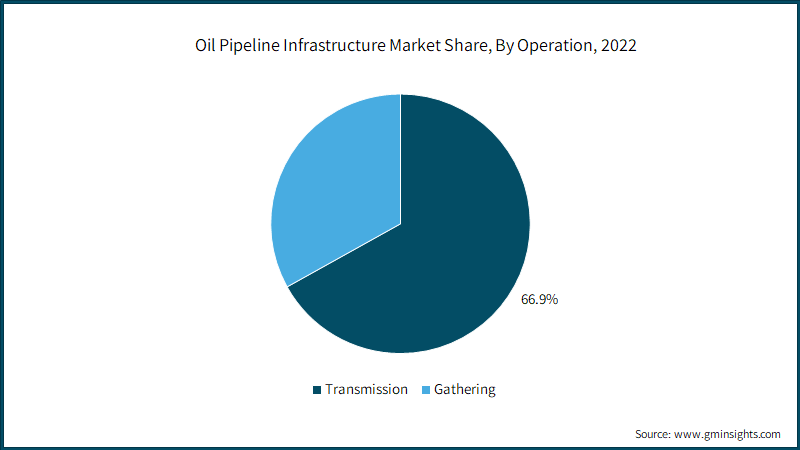Home > Energy & Power > Oil and Gas > Oil and Gas Infrastructure > Oil Pipeline Infrastructure Market
Oil Pipeline Infrastructure Market Analysis
- Report ID: GMI3277
- Published Date: Aug 2023
- Report Format: PDF
Oil Pipeline Infrastructure Market Analysis
The oil pipeline infrastructure market is segmented into onshore and offshore based on application. Onshore oil pipeline infrastructure held a market value of over USD 430 billion in 2022 and is anticipated to witness a market value over USD 575 billion by 2032. The growing global energy demand, particularly in emerging economies. As economies develop and industrialize, there is a greater need for efficient transportation of oil to meet the rising energy requirements. The development of onshore pipeline infrastructure supports economic activities, including industrial operations, power generation, and transportation sectors. Moreover, the discovery and development of new oil reserves, both conventional and unconventional, contribute to the need for onshore pipelines to transport the extracted oil.

Transmission pipelines obtain a major oil pipeline infrastructure market share of over 66% in 2022 and is anticipated to grow at a CAGR of over 3% by 2032 driven by factors such as increased oil production, the need for reliable supply routes, and the development of new oil fields. Existing transmission oil pipelines are being upgraded and modernized to improve efficiency, safety, and environmental performance. This includes the use of advanced monitoring systems, leak detection technologies, and pipeline integrity management practices. This includes the use of smart pipeline systems, remote monitoring and control, and predictive analytics for maintenance and asset management. In addition, stricter regulatory requirements pertaining to pipeline safety, environmental protection, and social responsibility.
Oil pipeline infrastructure market, based on diameter, is segmented in ≤ 8 Inch, >8-24 Inch and > 24 Inch pipes. Medium size pipelines ranging from 8 to 24 inches will witness a substantial rise in deployment in the coming years owing to the rapid industrialization and advancements in exploration and production (E&P) technology. Governments have allocated funds to advance and expand existing pipeline networks. These pipelines are commonly used as trunk lines to facilitate trade within and between countries. In addition, the growing international trade of oil has contributed to the demand for pipelines in this size range. As countries engage in global export and import of oil, these pipelines serve as vital conduits for cross-border transportation, supporting energy security and economic cooperation.

North America oil pipeline infrastructure market is expected to witness a substantial development at a CAGR of over 2.5% by 2032, owing to a substantial rise in investments by the government for the advancement and addition of greenfield infrastructure to bring resources to the industry. The rise in E&P investments across the U.S., which has led to an increase in rig count, will further drive the development of additional pipeline infrastructure. The economic development of previously disconnected resources has been facilitated by the introduction of technologies like directional drilling and hydraulic fracturing. The transmission capacity is set to increase further with the accelerated production from the Utica and Marcellus shale plays.
In the distribution sector, steady progress is anticipated as existing infrastructure is developed to comply with ongoing regulatory changes. Anti-pipeline sentiments, opposition from activist groups, and environmental concerns have posed challenges in obtaining clearance and developing pipeline projects. However, the U.S. government has demonstrated effectiveness in securing project approvals from the Federal Energy Regulatory Commission (FERC).

